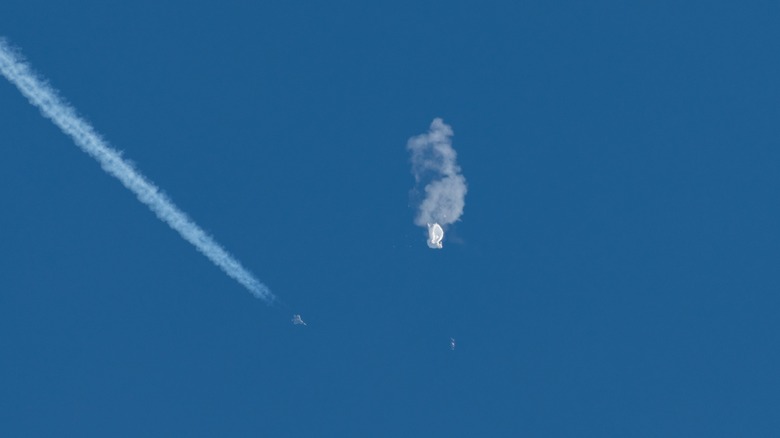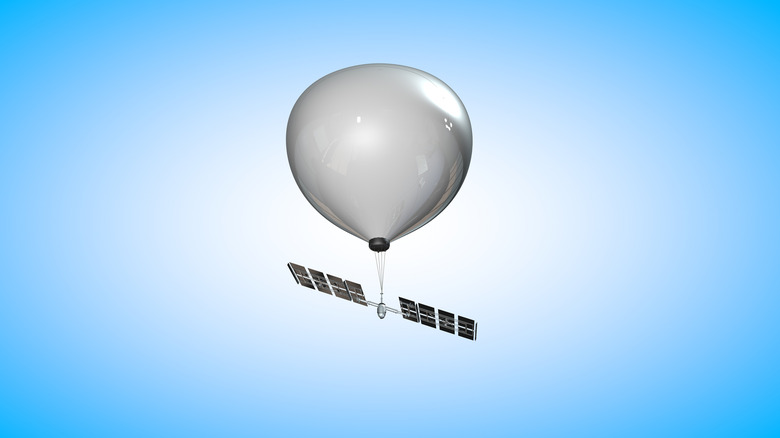Here's How Spy Balloons Actually Work
There has been a lot of talk recently about spy balloons. On February 6, President Biden addressed reporters on the South Lawn about Chinese incursions via these tools, according to The White House. The President noted that the situation is clear: "I told the Defense Department I wanted to shoot it down as soon as it was appropriate," he answered in response to questions about the timeline of events.
In total, U.S. military assets have shot down four high altitude objects since January 2023. These high flying objects have continued to float across the skies over Alaska, Canada, and the Lower 48 states, raising the question of what they can do and how they work.
For one thing, Iain Boyd writes for PBS that the internationally recognized boundary of a nation's upper limit lies at 62 miles, placing any balloon flying over the ground firmly within territorial jurisdiction. This means that the spy balloons that have been spotted over North America and elsewhere are definitively infringing on national territorial sovereignty as they make their way across the skies (whether over the United States or elsewhere).
Boyd is comforting in his analysis of what this means for Americans, stating: "The balloon doesn't pose any real threat to the U.S. I think sometimes China is just experimenting to see how far they can push things." Even so, it's worth taking a look at what these espionage tools are capable of and how they can be used within a variety of mission spaces.
Balloons have a storied history
Balloons have been a part of human history for centuries. They were initially ornamental creations, but soon became an integral part of warfare. Balloon devices were the first implementation of aerial combat, helping armies gain a sense of the battlefield below. A balloon could be raised up with a scout in order to glean troop size, movement, and more, which was then relayed to the ground commanders using a variety of signaling methods.
In its early iteration — used during China's Han Dynasty, unmanned balloons were raised as a signal themselves. They were often used to alert distant regiments of danger or call for support in the midst of a retreat. During the U.S. Civil War, balloons were deployed to support mapmaking operations, as a means to gather intelligence on Confederate movements, and even as a forward lookout position to direct accurate artillery fire.
Balloons remained an important intelligence and topographical asset for both military and civilian use until the rise of the modern aircraft took over these roles. Even still, German Zeppelins were used as bombers during World War I, and in the second World War, the U.S. Navy and British Air Force utilized balloons to hunt for submarines and blunt missile attacks.
Even as airplane technology has continued to advance, balloons have remained a valuable tool in the arsenals of many nations' war and intelligence gathering efforts.
Movement is limited, but capabilities are vast
The ability to navigate is significantly limited in a balloon. This has always been the case, and is one of the primary reasons that airplanes offer vastly superior capability in most applications.
Balloons are largely carried by wind currents. They can rise to as high as 100,000 feet above the Earth's surface, placing them squarely within the stratosphere as they silently cruise along. Some balloons are able to incorporate limited navigational ability to redirect and coast along favorable wind currents. However, the typical stratospheric balloon is launched with the prevailing weather patterns in mind in order to direct the device toward a target location. If patterns shift, there's no way to redirect the tool.
However, where balloons shine is in payload capabilities. These tools can remain in the sky for months without refueling or maintenance. With solar power, balloons can be outfitted to deliver overhead imagery, add radar detection, or bring communications equipment into a forward position that dramatically improves intelligence gathering capability.
Direct overhead imagery is routinely thought of as a satellite operation, but bringing the equipment closer to the Earth can make for improved resolution with the same technology. Where these tools become grisly is in weapons systems. Defensive systems rely on a trajectory to intercept or destroy an incoming projectile. But if it's dropped from directly overhead, defensive capacity is difficult. Fortunately, there's no evidence to support that this was the intention of recent balloon activity.
Modern balloons are primarily used for weather
While the Pentagon has continued to investigate potentially beneficial modern uses for balloon technology, this isn't the primary use case. Weather balloons are far more prevalent in today's stratosphere than any type of espionage tool or a dreaded weapon of warfare.
Hundreds of weather balloons are deployed on a daily basis across the world. The National Weather Service reports that it releases 92 balloons every day across the United States and U.S. territorial locations. The data relayed by the radiosonde instruments on weather balloons are pivotal for making accurate weather forecasts. Twice a day, weather services around the world deploy a fleet of latex or neoprene balloons that rise to 100,000 feet in altitude, and can travel as far as 125 miles over the course of a typical two-hour journey.
These balloons are primitive in comparison to the spy technology that's making headlines. These tools don't include powered features or a shell that can withstand flights beyond this limited capacity. However, the information gathered is crucial for people from all walks of life. The pressure, wind current, and moisture data that's brought back from the stratosphere helps individuals plan their daily routine and gives government agencies the tools they rely on to prepare for and mitigate the damage from natural disasters, such as hurricanes, wildfires, or blizzards.



